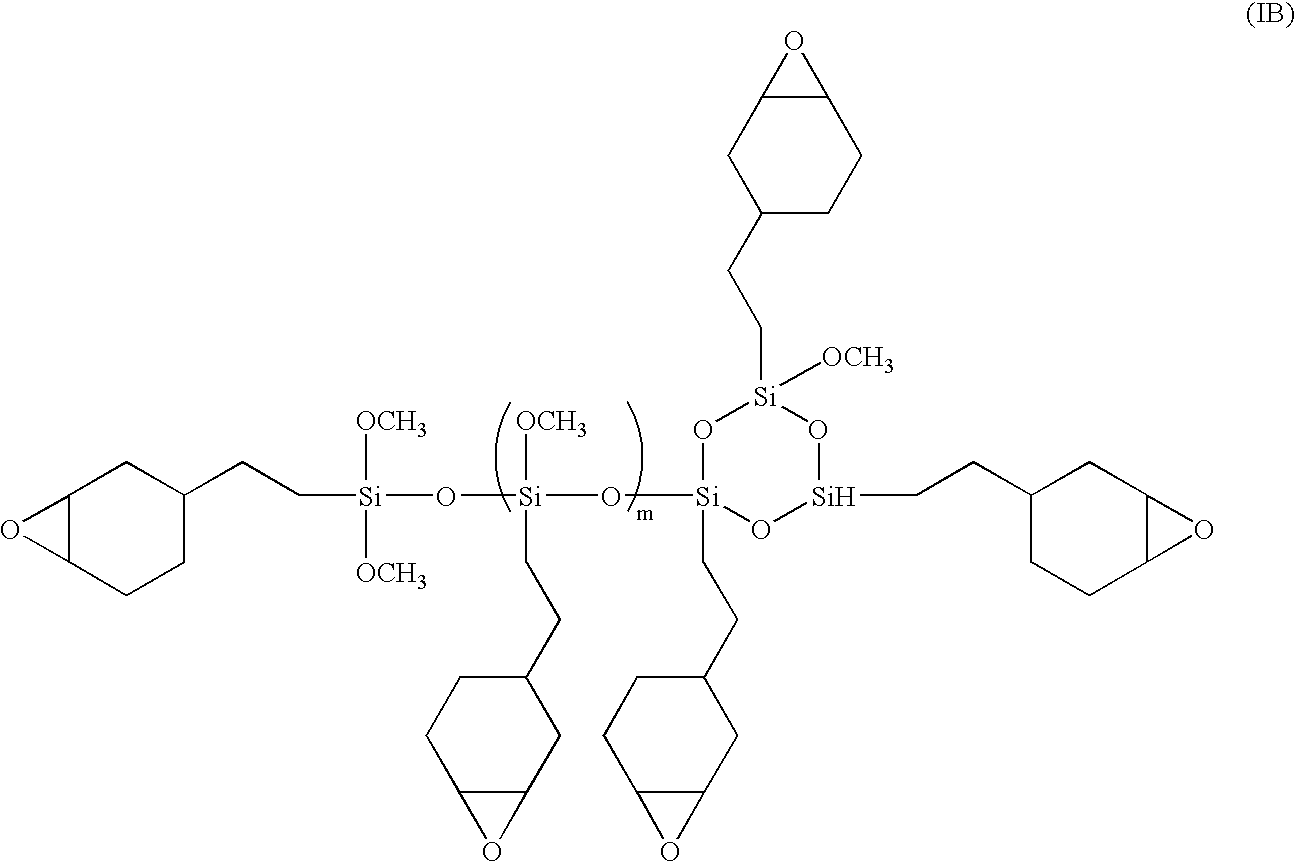Solventless, non-polluting radiation and thermal curable coatings
a technology of radiation and thermal curable coatings, which is applied in the direction of coatings, transportation and packaging, and synthetic resin layered products, etc., can solve the problems of mediocre coating performance, slow line speed, and the most recent use of non-polluting coating systems that only last about 30 years
- Summary
- Abstract
- Description
- Claims
- Application Information
AI Technical Summary
Benefits of technology
Problems solved by technology
Method used
Image
Examples
example 1
Thermal Cure
A formulation containing the following components was prepared and tested:
Formulation 1ComponentParts by Weight422130PC-100030PC-200330Capa 316 / 410110Silane A-1872PC-2506 (40%)3PC-2508 (40%)—Aluminum Substrate,5000 SeriesNon-CleanChromeChromeThermally Cured-Hotplate 177 C. 2 minAppearanceFish EyeNoneNoneNoneColorClearClearClearCureDryDryDryAdhesion Test (ASTM D 3359 Cross Hatch)After 24 hrs.PassPassPass1T Bend Test (ASTM D 522-88)After 24 hrs.PassPassPass
example 2
Thermal Cure
Formulations containing the following components were prepared and tested:
Formulation2A2B2CComponentParts by Weight6084 / 422130—30(20 / 80)6084 / 4221—30—(30 / 70)PC-1000303030PC-2003303030Capa316 / 4101101010Silane A-187222PC-2506 (40%)331PC-2508 (40%)——3Formulation2A2A2A2B2B2BAluminumCleanChromeNon-CleanChromeNon-Substrate, 5000 SeriesChromeChromeThermally Cured-Hotplate 177° C. 2 min.AppearanceFish EyeNoneNoneNoneNoneNoneNoneColorClearClearClearClearClearClearCureDryDryDryDryDryDryAdhesion Test (ASTM D 3359 Cross Hatch)After 24 hrsPassPassPassPassPassPass1T Bend Test (ASTM D 522-88)After 24 hrs.PassPassPassPassPassPassThermal and E-Beam Cure with and without PostbakeFormulation 2COtherAluminum Substrate, 5000 SeriesSubstrateNonNonNonALCleanChromeChromeChromeChromeChromeGalvalume36Thermally CuredHotplateYesYesYesNoNoNoNoNo177 C. 2 minE-Beam CuredVoltage (Kv)N / AN / AN / A120120120120120Dose (Mrad)N / AN / AN / A 6 6 6 6 6PostbakedN / AN / AN / AYesNoYesNoNo125° C. 15minAppearanceFish e...
example 3
Thermal Cure—or E-Beam Cure with Postbake
Formulations containing the following components were prepared and tested:
Formulation3A3B3C3D3EComponentParts by WeightVikoflex 9010 / 565350—40Araldite 6097(70 / 30)Vikoflex 9010 / ———46—Araldite 6084(80 / 20)PC-10004038363540PC-2003—5101510Silane A18722222Byk 501———0.2PC-2506 (40%)22222PC-2508 (40%)———6Formulation3A3BAluminumCleanCleanCleanNon-Non-LightingLightingSubstrate,ChromeChromeNon-Non-5000 SeriesChromeChromeThermally CuredHotplate1 min. 301 min. 301 min. 301 min. 451 min. 451 min. 451 min. 45203° C.sec.sec.sec.sec.sec.sec.sec.Postbaked1 hour15 min30 min.15 min30 min.15 min30 min.125° C.AppearanceCureDryDryDryDryDryDryDryImpact Test (ASTM D 2794) after 24 hours20 in. / lbs.———PassPassPassPass30 in. / lbs———PassFailFailFailFormulation3C3DAluminumCleanCleanCleanCleanCleanSubstrate,5000 SeriesThermally CuredHotplate1 min. 301 min. 451 min. 451 min.1 min. 15203° C.sec.sec.sec.10 sec.sec.Postbaked1 hour15 min30 min.1 hour1 hour.125° C.AppearanceC...
PUM
| Property | Measurement | Unit |
|---|---|---|
| wt. % | aaaaa | aaaaa |
| temperature | aaaaa | aaaaa |
| weight | aaaaa | aaaaa |
Abstract
Description
Claims
Application Information
 Login to View More
Login to View More - R&D
- Intellectual Property
- Life Sciences
- Materials
- Tech Scout
- Unparalleled Data Quality
- Higher Quality Content
- 60% Fewer Hallucinations
Browse by: Latest US Patents, China's latest patents, Technical Efficacy Thesaurus, Application Domain, Technology Topic, Popular Technical Reports.
© 2025 PatSnap. All rights reserved.Legal|Privacy policy|Modern Slavery Act Transparency Statement|Sitemap|About US| Contact US: help@patsnap.com



